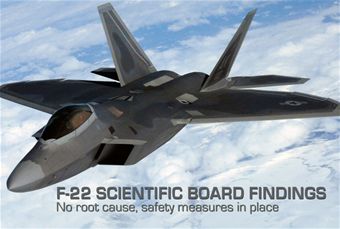 |
| News > F-22 scientific board findings announced pilot safety is priority |
 |
 |
| |
| Photos | |
 |
(U.S. Air force graphic/Sylvia Saab) (U.S. Air Force photo/Senior Airman Laura Turner)
|
Download HiRes
|
|
|
|
F-22 scientific board findings announced pilot safety is priority
Posted 3/30/2012
 Email story
Print story
Email story
Print story

by Mitch Gettle
Air Force Public Affairs Agency
3/30/2012 - WASHINGTON (AFNS) -- Air Force leaders provided an update on the Air Force Scientific Advisory Board study into the F-22 Raptor life support systems and flight operations during a briefing in the Pentagon March 29.
Retired Gen. Gregory Martin, an aviator and a former commander of two major commands, chaired the nine member SAB team which studied the aircrafts' on-board oxygen generation systems and briefed its findings and recommendations in trying to determine a root cause for pilots experiencing unexplained physiological events with the F-22 Raptor.
"From April 2008 until May 2011, the Air Force experienced 14 physiological incidents with the fleet of F-22s," Martin said. "Each incident was investigated, and of those incidents, 10 did not reveal a root cause."
It was the unexplained nature of those incidents that gave the Air Force concern and led the Secretary of the Air Force to ask for a broad area review which the SAB conducted, he added.
"We were unable to determine a root cause, but we were able to put in place the proper safety measures and risk mitigation techniques that would allow the F-22 fleet to return to fly...to ensure the integrity of the life support system," Martin said. "We went from ground test to flight test to a return to fly phase, and moving into a transition phase."
The advisory board made nine findings and 14 recommendations based on a seven-month study of the F-22's evolution - from conception and acquisition through current flight operations - which the Air Force can use to move forward.
Martin said the findings and recommendations fall into three main areas; the acquisition processes and policies, the organizational structure recommendations and equipment recommendations to not only protect the pilots and crew members today but also for the future.
"Some of the things we recommended give us a much better understating of the pilots' performance in those environments that we have not operated in before," Martin said. "It will further our understanding of the aviation physiology of operating in that environment."
Air Force leaders remain steadfast that the F-22 is a fully combat capable aircraft and they have every confidence in its current and future performance.
"Since September of last year we've flown over 10,000 sorties," said Maj. Gen. Charles Lyon, Air Combat Command Director of Operations. "We've had a 99.9 percent effective flying rate relative to physiological incidents, but that is not good enough. We will not rest; we will not stop; we will not end this journey we are on until we carry that 99 percent decimal point to the farthest right that we can."
The Air Force is well into the implementation phase of the recommendations from the SAB team and continues to aggressively pursue the root cause of these unexplained incidents, he said.
"Let there be no doubt that safety is paramount to the men and women who operate (the F-22) and the commander's who command them," Lyon said. "When we wear this uniform there is risk, there is risk inherent in aviation and risk inherently in conducting military operations.
Pilot safety has and always will remain a priority for ACC, Lyon added.
"We have taken a 9-1-1 call approach" Lyon said. "We have instructed and talked to our members in the field; whenever you get any indication that something may not be right, knock it off, the flying equivalent of calling 9-1-1 and terminate the flight. All eyes are focused on you and the safe recovery of your aircraft."
When a physiological event occurs, the pilot is met by a medical team to care for the pilot and take additional tests and send the tests to the lab, and so far nothing remarkable has come back from the lab tests we've analyzed, he said.
"When it comes to safety, no one second guesses the pilot," Lyon said.
The F-22 is a fifth generation fighter and one that is needed for the United States to establish air superiority in today's and tomorrow's conflict's, said Maj. Gen. Noel "Tom" Jones, Air Force Deputy Chief of Staff for Operations, Plans and Requirements.
"This aircraft is the world's most advanced aircraft and does air superiority mission unlike any other aircraft in the world," Jones said. "This is the leading edge of technology, and if our nation needs a capability to enter contested airspace to deal with air forces that are trying to deny our forces the ability to maneuver without prejudice on the ground; it will be the F-22 that takes on that mission."
|
|
|
|
| Mykal Donathan, RAF Lakenheath UK |
| |
|
| DG, Holloman AFB |
| |
|
| DG, Holloman AFB NM |
| |
|
| really, reality |
| |
|
| Caveman, Bedrock |
| |
|
| RL, Shaw AFB |
| |
|
| JT, Tampa |
| |
|
| Capt MRC Pilot, Louisville KY |
| |
|
| SNCO Retired, Ohio |
| |
|
| DC, MD |
| |
|
| Add a comment
|
|
|
|
|
 |
|



